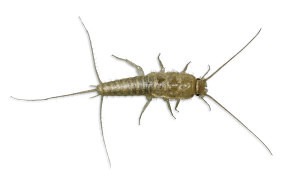Silverfish
There are several types of pests that are particularly good at remaining undetected while active inside your home. Of those pests, one of the most common is the silverfish.
Silverfish are small insects. They are grayish-blue in coloration, and are approximately 3/4 inch in length. They are often described as “teardrop shaped” and have three long bristles extending from the rear of their body. As they develop, silverfish undergo the process of gradual metamorphosis, and for this reason they are indistinguishable in appearance from when they hatch to adulthood.
Silverfish can survive in almost any environmental conditions, however they typically prefer dark areas with high humidity. Areas that fit this description are plentiful around the home, and many times silverfish can be found in secluded areas such as basements, vents, storage areas, and bathrooms. Silverfish are nocturnal and will spend the daylight hours in hiding. Their nocturnal habits, as well as their choice of generally secluded spaces, can make it very difficult for homeowners to locate the source of a silverfish infestation.
Silverfish can reproduce relatively quickly. Though rates of reproduction vary by species, in some cases each individual female can lay clusters of eggs daily. In areas of high humidity, silverfish reproduce more quickly, and can become a major problem in your home in a short period of time.
The diet of the silverfish consists almost entirely of carbohydrates. They feed on almost any kind of starch or sugar, and can consume cellulose products, shampoos, glue, paper, and dead insects. Silverfish are notorious for getting inside food storage containers. Once they are inside, they will contaminate the food and this can cause a great deal of food waste if left unchecked.
While they do not cause any structural damage to homes, silverfish can ruin any papers, clothing, and food they are able to access. This can be a major frustration for homeowners because it is often difficult to identify what pest is causing the damage and where the source of the infestation is located within the home.
Like many pests, the best way for homeowners to deal with silverfish is to prevent an infestation in the first place. Removing conditions that are conducive for infestation, such as high humidity in vents and crawlspaces, can help to keep silverfish out of secluded areas in and around your home.
If an infestation is already active inside your home, it can be difficult to deal with without professional assistance. Many DIY pest products only work to eliminate silverfish while they are moving at night, and therefore do nothing to deal with the source of the infestation. If you are dealing with a severe infestation of silverfish, it is almost always easier to rely on a professional pest service to eliminate the problem.
Here at Canton Termite and Pest Control, our team has decades of experience dealing with pests of all kinds. Our technicians can thoroughly inspect your home, locate the source of the problem, and provide you with the best solutions to deal with your particular situation!
So if you are having problems with silverfish, or simply have a question, call us today at 770-479-1598! We will be happy to help you in any way that we can!
Here’s to YOU living pest free!
By: Tim

